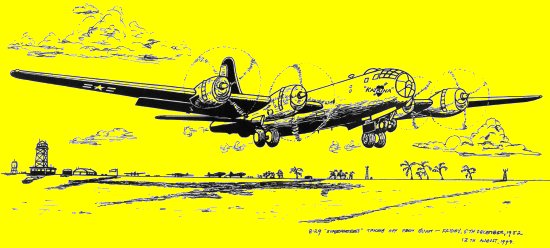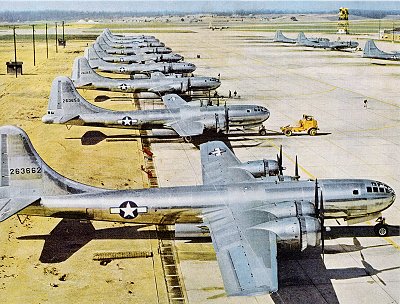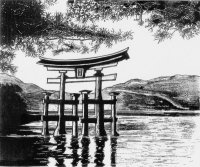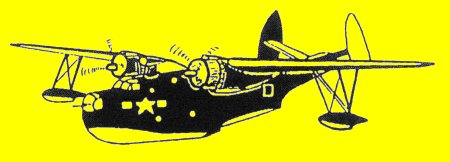
QANTAS EMPIRE AIRWAYS

 | FLYING TO JAPAN QANTAS EMPIRE AIRWAYS |  |
| Wednesday 3rd December, 1952 We started off with a parade and then cleaning our gear. We wereon alert all day waiting to be told we were going to Japan at last! I went home on leave to Normanhurst and went to the Hornsbypicture theatre with two of my friends at night. The two lastpictures I would see in Australia, I hoped I would see morepictures back here, sometime in the unknown future. The firstpicture "The Clouded Yellow" featured Jean Simmons and thesecond movie appropriate to the South East Asia area where I wasgoing the next day was "Macau" featuring Robert Mitcham andJane Russell.
This is the day. General parade early, then made phone calls to let friends andrelations know I was leaving Australia tonight. We left Inglebumat 7.20 p.m. on the back of trucks, there was about 40 of us totravel on the aircraft to Japan at a time. We arrived at the MascotInternational Terminal at about 9.30 p.m. My brother Alan, hiswife Gwen and their two young children Ruth and Robyn arrivedto see us off. Dawn, my girlfriend at the time, also came. There were about 100 people at Mascot to see the soldiers off,mainly friends and relations. The aircraft was scheduled to leaveat 10.00 p.m., but we didn't leave till 10.55 p.m. The good olddays at Mascot, everybody was waving and taking photos of us aswe climbed the stairs onto the aircraft. I settled into my seat,second last window seat on the left side, good for taking photos. Here I was about to have my first aeroplane ride in my favouriteaircraft, a Douglas D.C.-4 "Skymaster" one of six in the Qantasfleet at the time. Our aircraft took off to the north, the four Pratt and Whitney R-2000-5's (1450horsepower each) enabling us to climb smoothly over northernSydney to our cruise altitude of 8500 feet. Settling down to a cruise of 200 m.p.h., as this aircraft's range was2500 miles. We were to call in at Port Moresby, in Papua NewGuinea, and Guam in the Mariana group of islands to rest and refuel. The lights of Newcastle showed below and then got sparser as wecruised our way up to the New South Wales coast. The two pilotsand flight engineer settled the engines into perfectsynchronisation. I was getting tired and rested the left side of myweary head on the plastic oval window frame. The vibration of the motorslulled me to sleep about midnight. I woke up at 4.50 a.m. The sun was just below the horizon on thestarboard side (right side) shining a pink/purple colour on the lightclouds to the west. After a while full daylight and waves on the Coral Sea at about9,000 feet below us. I felt a high, thinking to myself, here I am inmy first aeroplane and two more days ahead in this environment.Suddenly a cold shudder went through me as I thought to myself"I wonder if I will ever come back?" I quickly dismissed thesethoughts, settling back to enjoy the colourful clouds drifting by.About 7 a.m. the New Guinea coast came up, we banked slightlyand followed the coastline all the way to Port Moresby. Below I spotted a Consolidated B-24 "Liberator" lying in the cleargreen water between 20 and 100 feet deep. The aircraft was stillintact with its 4 motors on long tapered wings and distinctive twintail fins and rudders. After 7 or so years in the water it hadn'tbroken up.
We landed at Port Moresby at 8 a,m. and were told we would bestaying here for about I hour, while the aircraft was beingrefuelled~ We climbed out and straight away a wave of hot humidair hit me. I spotted a couple of bi-planes and two Noorduyn"Norseman's" next to some hangers. I walked over to study theseaircraft and started to strike up a conversation with a Papuannative, sitting in the shade (he was probably employed at theairport). I didn't know "pidgin" English, and he didn't seem tounderstand what I was talking about, so we just ended up grinningat each other. A giant orange wasp flew onto my arm, lucky I hadmy army long sleeve shirt on. I went back to where our D.C.-4was parked. These giant bugs in the tropics didn't appeal to me.  We took off at 9.30 a.m., we were told if we got cold to use theblankets which were in the lockers above our heads. I wonderedwhy, as we were in the tropics, and only cruised at about 9,000 ft.After the take-offthe pilot circled the airport area about 10 times,climbing higher and higher each circle. When we got to about10,000 ft the pilot set track north still climbing. It soon becameclear to me about the blankets. Every few miles, the ground camecloser to us; we levelled off at 12,000 ft. We flew through a passof the Owen Stanley Ranges, the hills on either side level with us,and light clouds hovering above these hills. Little villages justbelow us now and then, little round thatched huts and sometimes alarge one around the small ones. The hills got further below us asthe other side of the ranges changed to lower land. We graduallycame back down to our cruise altitude. I was tough, I didn't need ablanket.
We landed at Guam at 6 p.m. after a smooth flight all the way fromAustralia, not running into any tropical storms.As we taxied to the USAF terminalI spotted a World War Two Boeing B-17"Flying Fortress" moving across the airfield. I was very excited.The other soldiers thought I was a nut. I don't think any of theother soldiers were aviation buffs like me. This is the only"Flying Fortress" I had ever seen, and the only one I would eversee. The only way to see one of these aircraft today is to go to airshows in the United States of America, and sometimes in theUnited Kingdom.  The B-17 "Flying Fortress" is remembered in the film made only afew years ago called "Memphis Belle" the true story of a U.S.A.F.B-17, that completed 25 missions over Germany and bolstered theAmerican morale when this aircraft was taken back to the U.S.A.about 1944. The aircraft is now "Pride of Place" in a museum inMemphis, Tennessee. After we had all disembarked off the aircraft we walked over to abus stop. Buses to pick us up and take us a short distance to ourassigned sleeping barracks. The buses pulled up with U.S.servicemen on board and other residents of the Island of Guam.We walked along the side of the bus then went to the back, then tothe front We couldn't find the door to get in. The passengerswere rather amused. Eventually the door was found on the otherside of the bus. This was our first experience with left-hand drive,as this was U.S. Territory. We placed our "kit bags and gear" andrifles into our quarters, then I had a shower to freshen up. Most ofthe soldiers went looking for a "wet" canteen, I headed for the rowof B-29, Boeing "Superfortresses" lined up on the apron.  These aircraft (4 engined super-giants) were on stand-by for otherPacific Island bases to bomb North Korea. It was now about 7p.m. and no one around these aircraft, probably at the canteens, Ispotted a ladder up against the nose of one of these aircraft. Stillin my slouch hat, army uniform and hob nail boots, I climbed ontothe wings, and walked from one wingtip to the other (141 ftwingspan). Being careful not to scratch the aluminium skin andnot to slip on the metal panels with the army hobnail boots, as thewings were approximately 11 feet off the concrete apron. Afterabout 10 minutes I climbed back down the ladder and stoodlooking at the giant 4 bladed propellers (16.7" diameter). Thesefour engined high altitude bombers also made history as a B-29"Superfortress", "Enola Gay" was used to drop the first Atombomb on Hiroshima, Japan 6th August, 1945, and another B-29dropped another Atom bomb on Nagasaki a couple of days later. Iwent back to the barracks; lucky no one had challenged meclimbing on the aircraft. I could have been in big trouble.  As none of my soldier friends were about, I went and found acanteen to try and get a soft drink. I found one; Americanservicemen were around having drinks and food. I had noAmerican money and approached the gentleman behind thecounter to try and get a soft drink. I got a large sheet of one-penny Australian stamps out of my wallet to exchange for a drink.The man serving, I think he was Negro, just looked at mestrangely. By this time other men in the canteen had crowdedaround me to see what was going on, they then drifted off, but acouple of young Americans about my age felt sorry for me andbought me a drink, and then took me "under their wing". Theyinvited me to go to the service's open-air movies, which wereabout to start. (This was my first open-air movie that I had beento.) They paid my 25 cents admittance. First there were shortsand news, then a cartoon about "Sylvester and Tweetie Pie"; myAmerican friends explained to me that the cat always tried tocatch the yellow bird. I didn't have the heart to tell them that I hadseen "Sylvester and Tweetie Pie" back in "The Land DownUnder". The main picture was called "My man and I" starringShelley Winters and RichardoMontalban. After the show I saidgoodbye to these American pals, and climbed into bed at 12.15a.m.  Saturday 6th December. 1952 The next morning, we were woken up at 5 a.m., and boarded ourtrusty D.C.-4 steed in the darkness. We took off at 6.15 a.m.There was one soldier missing. He had gone drinking withAmerican friends and ended up sleeping in the wrong barracksand was woken up too late. He managed to get a lift on a U.S.aircraft to Tokyo; from there he got a lift on another aircraft tolwakuni, and arrived at our Hire camp a few days after us. As faras I know he was fined a small amount for being "absent withoutleave". The army was sympathetic and understood what hadhappened. We had our first view of Japan flying over the terraced paddyfields on the Island ofShikoku, gradually descending and landingat lwakuni Air Base, Japan at 5 p.m. on the southern part of theIsland of Honshu.  This airbase was used for a stopping off stage for many aircraftflying to Korea, with troops and supplies. Here we boarded asmall ferry manned by Americans to take us across the stretch ofwater to Kure Docks. The crew passed out cans of beer to theAustralian soldiers. I managed to secure a "C" ration pack full ofgoodies to munch on for weeks after. As the ferry took us acrossthe short stretch of water I noticed two dark blue Martin PB.M."Mariners" tied up to the pier. These twin engined flying boatswith their distinctive "V" shaped tailplane and twin rudders wereused for air-sea rescues and over water patrols off Japan andKorea.  After leaving the city of Kure we arrived at the Ist R.H.U.(Ist Recruit Holding Unit) on the outskirts of the town of Hireabout 10 miles away. We arrived there at 7 p.m., had tea, andthen issued with more gear. I was very tired but pleased with theadventures of the last three days. I finally got on to my campstretcher at 11 p.m.  10 Platoon, "DI' Company, 2nd Battalion The Royal Australian Regiment, Korea 1953
|
|
| © Australian Album © |